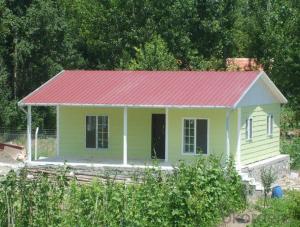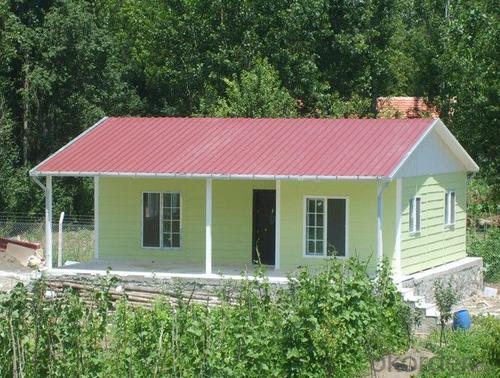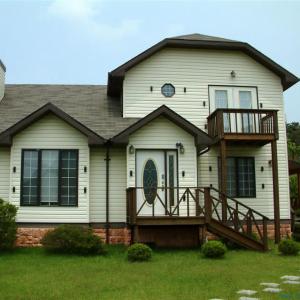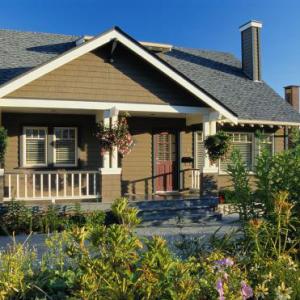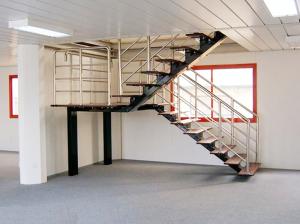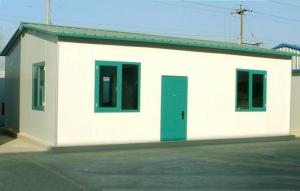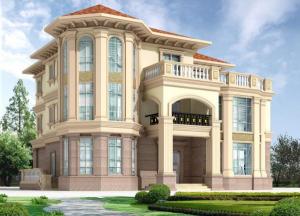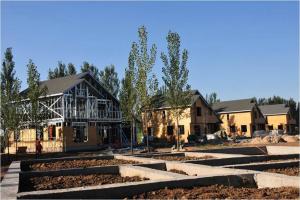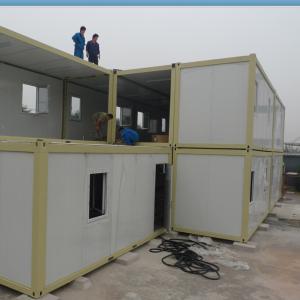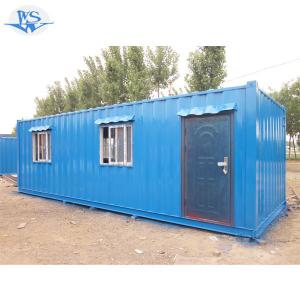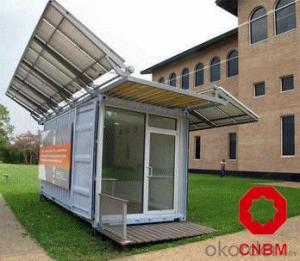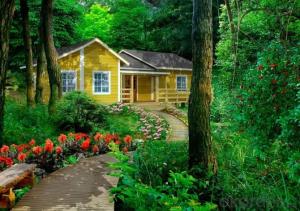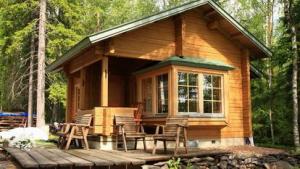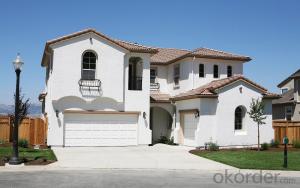Good Quality Mobile House Made in China
- Loading Port:
- China Main Port
- Payment Terms:
- TT OR LC
- Min Order Qty:
- -
- Supply Capability:
- -
OKorder Service Pledge
OKorder Financial Service
You Might Also Like
prefabricated steel building Feature:
* Prefabrication, easy to install and disassemble
* Precision works, long life-span up to 15 years for use
* Lightness, easy to transport and relocate
* Using several times and recycling, economy and environment friendly
Prefab house Main material list as following:
Wall: 50mm/75mm thick EPS/Rockwool/PU sandwich panel
Roof: 50mm/75mm thick EPS/Rockwool/PU corrugated sandwich panel
Window: UPVC or Aluminum sliding window
Door: aluminum frame with panel same as wall panels(security door as optional)
Prefab house Joint material: steel column/aluminum alloy
1. Free from the damages by inspects, such as white ants and so on
2. Steel code: Q345, Q235
3. Designed life span: more than 30 years;
4. Green and environment-friendly materials used;
5. Seismic resistance up to 8 magnitudes
6. Safe---Able to stands for maximum 55 m/s typhoon
7. Advanced roof and wall cladding material guarantee excellent acoustic insulation, less 65% energy consumption than the concrete structure.
8. Additional 10%-15% net area compared to the traditional building, air cavity between the cladding and main structure guarantees the comfortable indoor space.
Prefab house advantage
1. Easy and quick to install;
2. Excellent load and span capabilities;
3. Significant savings in site installation costs;
4. Panel comes in a range of aesthetically pleasuring colors;
5. Energy saving thermal insulation;
6. Superior air tightness for controlled environments;
7. Good reactions to fire properties;
8. Durable, long lasting, stood the test of time in the extremes of harsh climate
- Q: Are container houses considered sustainable housing options?
- Yes, container houses are considered sustainable housing options. They are made from repurposed shipping containers, which reduces waste and carbon emissions associated with traditional construction materials. Additionally, container houses can be designed to be energy-efficient, incorporating solar panels, rainwater harvesting systems, and insulation to lower environmental impact.
- Q: Can container houses be rented out?
- Indeed, it is possible to rent out container houses. These dwellings have gained considerable popularity due to their sustainability and affordability as housing options. Their design facilitates easy transportation and conversion into cozy living spaces. Numerous individuals opt to lease container houses instead of conventional apartments or houses. This endeavor can prove to be a profitable business venture, particularly in regions where housing demand is high or for individuals seeking distinctive and environmentally friendly accommodations. Moreover, container houses can be personalized and furnished with all essential amenities, rendering them appealing choices for potential tenants.
- Q: Can container houses be built in remote areas?
- Container houses can certainly be constructed in remote areas. In fact, remote locations are particularly suitable for container houses because of their modular design and easy transportability. Due to their origin from shipping containers, they can be transported by trucks, boats, or even helicopters, making them accessible in areas with limited infrastructure. Container houses are also renowned for their durability and resistance to extreme weather conditions, which is especially crucial in remote areas where natural elements can pose more difficulties. They are built to be sturdy and capable of withstanding hurricanes, earthquakes, and other environmental factors. Furthermore, the construction of container houses is relatively quick and straightforward. Once the shipping containers are delivered to the site, they can be transformed into livable spaces by adding doors, windows, insulation, plumbing, and electrical systems. This means that even in remote areas with limited construction resources, container houses can be assembled efficiently. Moreover, container houses bring sustainability benefits to remote areas. They can be constructed using eco-friendly materials and can be designed to operate off-grid by utilizing solar panels, rainwater harvesting systems, and composting toilets. This makes them an ideal choice for remote areas where access to utilities and services may be limited or nonexistent. In conclusion, container houses present an excellent solution for remote areas, providing a cost-effective, durable, and sustainable housing option that can be easily transported and assembled even in challenging locations.
- Q: Are container houses suitable for areas with limited budget for construction?
- Yes, container houses are highly suitable for areas with limited budgets for construction. Container houses are an affordable alternative to traditional housing, making them an ideal choice for areas with financial constraints. The cost of purchasing and converting shipping containers into livable spaces is significantly lower compared to building a conventional home from scratch. Additionally, container houses require less time and labor during construction, further reducing costs. Despite their affordability, container houses can still provide all the necessary amenities and comfort needed for a functional living space. Moreover, container houses are highly customizable, allowing individuals to tailor their homes according to their specific needs and preferences. Overall, container houses offer a cost-effective solution for areas with limited budgets for construction, providing an opportunity for affordable housing options.
- Q: How are container houses heated and cooled?
- Container houses can be heated and cooled through various methods. For heating, containers can be equipped with insulation to retain heat, and heating systems such as electric heaters, wood-burning stoves, or even radiant floor heating can be installed. Similarly, for cooling, insulation and ventilation systems such as air conditioning units or fans can be utilized. Additionally, some container houses may make use of passive cooling techniques like shading or natural ventilation to regulate the indoor temperature.
- Q: Are container houses comfortable to live in?
- Yes, container houses can be comfortable to live in. While they may have some limitations compared to traditional homes, such as limited space and insulation challenges, with the right design and modifications, container houses can provide a comfortable living environment. One advantage of container houses is their versatility. They can be customized and modified to suit individual needs and preferences. From the layout and interior design to the addition of windows, doors, and insulation, container houses can be designed to maximize comfort and functionality. Furthermore, container houses can be equipped with all the necessary amenities for a comfortable living experience. Plumbing, electricity, heating, and cooling systems can all be installed to provide the same level of convenience as a traditional home. Additionally, container houses can be fitted with various sustainable features, such as solar panels and rainwater harvesting systems, making them eco-friendly and cost-efficient. It's important to note that insulation is a key factor in ensuring comfort in container houses. Proper insulation can regulate temperature, reduce noise, and prevent condensation. Adding insulation materials like foam or spray insulation can significantly improve the comfort level of container houses. Lastly, container houses offer unique benefits that can enhance the living experience. They are often more affordable than traditional homes, making homeownership more accessible. Additionally, their modular nature allows for easy expansion or relocation if needed, providing flexibility and adaptability. In conclusion, while container houses may have some limitations, with the right modifications and design choices, they can be comfortable and enjoyable to live in. These houses offer versatility, customization options, and the potential for sustainable living, making them a viable and comfortable alternative to traditional homes.
- Q: Are container houses suitable for areas with limited access to skilled labor?
- Yes, container houses are suitable for areas with limited access to skilled labor. Container houses are designed for easy and quick construction, requiring minimal labor and expertise. They come prefabricated and can be easily transported to remote locations, making them a convenient solution for areas with limited skilled labor. Additionally, container houses are designed to be simple and straightforward to assemble, with step-by-step instructions provided. Hence, they provide a viable housing option for areas where skilled labor may be scarce or difficult to access.
- Q: Are container houses suitable for mountainous regions?
- Yes, container houses are suitable for mountainous regions. The structural integrity and durability of shipping containers make them an excellent choice for areas with rugged terrain and harsh weather conditions. Container houses can withstand heavy snow loads, high winds, and even earthquakes, making them a reliable housing option in mountainous regions where traditional construction materials may not be as robust. Furthermore, container houses can be easily transported and installed in remote areas, which is often the case in mountainous regions. The modular nature of shipping containers allows for easy assembly and disassembly, making them ideal for locations with limited accessibility. Additionally, the compact size of containers makes them suitable for small plots of land, which are often found in mountainous areas. Moreover, container houses can be designed to be energy-efficient and environmentally friendly. They can be equipped with insulation, solar panels, and other sustainable features, ensuring that they are well-suited for the challenging climate conditions of mountainous regions. This not only provides a comfortable living environment for residents but also reduces their ecological footprint. In conclusion, container houses are indeed suitable for mountainous regions. Their durability, mobility, and adaptability make them an excellent housing solution that can withstand the unique challenges of living in rugged terrains.
- Q: Can container houses be built with a traditional bedroom layout?
- Certainly, container houses can incorporate a traditional bedroom arrangement. Although container houses are commonly associated with minimalist and open floor plans, they can be specifically designed to accommodate more conventional bedroom setups. With careful consideration and innovative design, containers can be modified to feature separate bedrooms complete with walls, doors, windows, and even traditional furniture such as beds, wardrobes, and bedside tables. One approach to achieving a traditional bedroom layout in a container house involves stacking or combining multiple containers to expand the available space. By vertically or horizontally connecting containers, it is possible to create larger rooms that comfortably accommodate a bedroom arrangement with ample space for a bed, furniture, and storage. Another option is to incorporate a combination of container and traditional construction methods in the design of the container house. This approach offers greater flexibility in terms of layout and allows for the creation of designated bedrooms with walls that separate them from the rest of the house. It is important to bear in mind that container houses have limitations in terms of size and structural integrity. However, with careful planning and the assistance of professional architects and engineers, it is certainly feasible to construct a container house with a traditional bedroom layout that caters to your specific needs and preferences.
- Q: Are container houses suitable for temporary or mobile living?
- Container houses are a great option for temporary or mobile living since they are specifically constructed for easy transport and setup in various locations. This makes them perfect for individuals who frequently relocate or require temporary housing. Constructed using sturdy materials, container houses are capable of withstanding transportation and harsh weather conditions, ensuring a secure and comfortable living environment. Moreover, container houses can be personalized and altered to cater to specific requirements and preferences, thus providing flexibility for temporary or mobile living arrangements. The space-efficient design of container houses also enables efficient utilization of space, making them suitable for compact living areas or temporary housing necessities. All in all, container houses present a practical and convenient solution for those in search of temporary or mobile living alternatives.
Send your message to us
Good Quality Mobile House Made in China
- Loading Port:
- China Main Port
- Payment Terms:
- TT OR LC
- Min Order Qty:
- -
- Supply Capability:
- -
OKorder Service Pledge
OKorder Financial Service
Similar products
Hot products
Hot Searches
